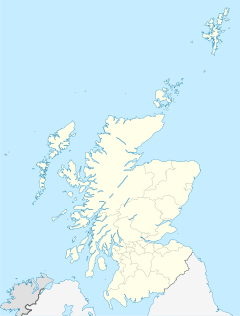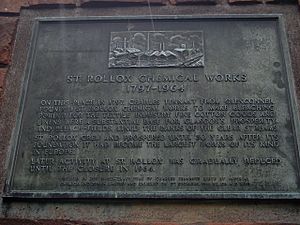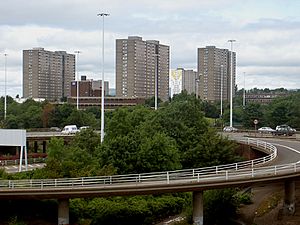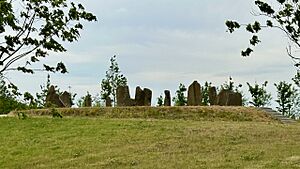Sighthill, Glasgow facts for kids
Quick facts for kids Sighthill
|
|
|---|---|
| OS grid reference | NS601665 |
| Council area | |
| Lieutenancy area |
|
| Country | Scotland |
| Sovereign state | United Kingdom |
| Post town | GLASGOW |
| Postcode district | G21 |
| Dialling code | 0141 |
| Ambulance | Scottish |
| EU Parliament | Scotland |
| UK Parliament |
|
| Scottish Parliament | |
Sighthill is a neighborhood in Glasgow, a big city in Scotland. It's located north of the River Clyde and is part of the larger Springburn area in northern Glasgow.
Sighthill has Cowlairs to its north and the Springburn Bypass and Royston to its east. To the west is a railway line leading to Queen Street Station, and to the south is the M8 Motorway.
This area is mostly for homes. From the mid-1960s, it had a large housing estate. This estate was split into two parts: Pinkston in the south and Fountainwell in the north. Each part had five tall, 20-story tower blocks. There were also seven 5-story apartment buildings and rows of older homes called tenements. Most of these buildings were taken down in the early 2000s. New homes, parks, and roads have been built in their place.
Contents
History of Sighthill
Sighthill was part of a big city plan called the Springburn Comprehensive Development Area. This plan aimed to knock down old, poor-quality homes and build new, modern housing estates. The Sighthill homes were built between 1964 and 1969. They replaced older tenement buildings in the area.
Much of the land for the Pinkston area was once called 'Soda Waste'. This was a dumping ground for waste chemicals from the United Alkali Company's St Rollox Chemical Works. This factory, started by Charles Tennant, was once the world's largest chemical maker. It closed in 1964. The Fountainwell area was built on an old farm.
The Sighthill Cemetery opened in 1840. Inside it, you can find a memorial to John Baird and Andrew Hardie. They were leaders of the 1820 Radical War, also known as the 1820 Insurrection.
Changes to the Area
The Pinkston power station used to provide electricity for Glasgow's tram system and the Subway. It closed in 1975. Its tall cooling tower, a famous part of the city's skyline, was taken down in 1977. The rest of the station was removed the next year.
Over time, living in high-rise buildings became less popular. Sighthill's tower blocks had many empty flats from the mid-1970s. Even though it was close to the city center, not many people wanted to live there. Because of this, Sighthill became a temporary home for refugees and people seeking asylum in the late 1990s. This made the neighborhood one of the most diverse places in Scotland.
In 2005, new landlords, Glasgow Housing Association, stopped renting out flats in Fountainwell. They decided to demolish the buildings there. The first two blocks were taken down in July 2008. The last three blocks followed in November 2009. Sighthill Primary School was also demolished after the tower blocks due to a fire.
The future of the five Pinkston blocks was discussed for a while. Local residents wanted to keep and fix up at least two of them. However, Glasgow then tried to host the 2018 Youth Olympics. To do this, they needed to build an Athletes Village. This led to the decision to demolish all of Sighthill's towers to make way for new, lower buildings. Glasgow did not win the Olympic bid, but the rebuilding continued.
Sighthill's New Look
The Sighthill 'Transformational Regeneration Area' project is bringing many changes. It includes a new school campus, green parks, and better connections to the Forth and Clyde Canal. About 1,000 new homes are being built for sale, private rent, and social rent. Many of these new homes are called 'NorthBridge'.
The Sighthill Bridge over the M8 Motorway opened in 2023. This bridge replaced an older, smaller pedestrian bridge. Locals call it the Rusty Bridge because it's made of a special steel called Cor-Ten steel. The bridge weighs 1,000 tonnes and spans 74 meters (80 yards). It has been decorated with thousands of plants and seating areas.
There is also an active Community Council in Sighthill. This group of local residents works to solve issues and improve the neighborhood.
Sighthill Stone Circle
Sighthill is home to a special stone circle. It was the first stone circle built in Great Britain in 3,000 years that lines up with the stars. It was designed by Duncan Lunan. The stone circle is at the highest point of Sighthill Park, giving it great views of the area.
There are 17 stones in the circle. Sixteen stones form a circle about 30 feet (9 meters) across. The largest stone, weighing four tonnes, is in the center. This stone circle was built to honor both ancient stone builders and the scientists who studied them. It was updated in the late 2010s as part of the area's renewal.
Tower Blocks in Sighthill
Each of the original tower blocks had 228 flats, meaning there were 2,280 homes across all 10 blocks. Each block was like two towers joined together, with separate entrances. They were about 57.6 meters tall.
Fountainwell Tower Blocks
These blocks were demolished in the following order:
- Eagle Heights (demolished: July 13, 2008)
- Barony Heights (demolished: July 13, 2008)
- Tennant Heights (demolished: November 29, 2009)
- Phoenix Heights (demolished: November 29, 2009)
- St. Rollox Heights (demolished: November 29, 2009)
Pinkston Tower Blocks
These blocks were demolished in the following order:
- Parson Heights (demolished: June 2013)
- Huntingdon Heights (demolished: September/October 2013)
- Pinkston Heights (demolished: April 2014)
- Crawfurd Heights (demolished: March–June 2016)
- Hartfield Heights (demolished: July–October 2016)





